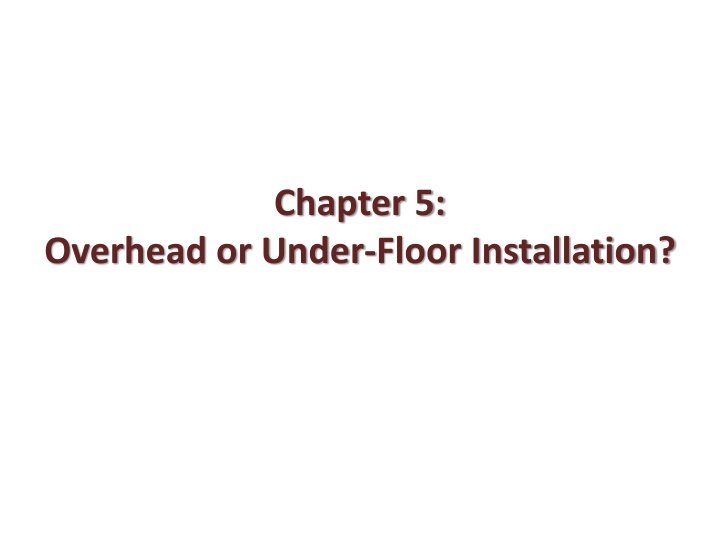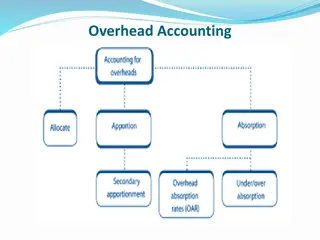
Ceiling vs. Raised Floor Installation: Pros and Cons
Explore the benefits and drawbacks of ceiling and raised floor installations for powering, data connections, and cooling systems in data centers. Understand the components, common issues, and considerations for deciding between overhead and under-floor setups based on data center size and needs.
Download Presentation

Please find below an Image/Link to download the presentation.
The content on the website is provided AS IS for your information and personal use only. It may not be sold, licensed, or shared on other websites without obtaining consent from the author. If you encounter any issues during the download, it is possible that the publisher has removed the file from their server.
You are allowed to download the files provided on this website for personal or commercial use, subject to the condition that they are used lawfully. All files are the property of their respective owners.
The content on the website is provided AS IS for your information and personal use only. It may not be sold, licensed, or shared on other websites without obtaining consent from the author.
E N D
Presentation Transcript
Chapter 5: Overhead or Under-Floor Installation?
What You Will Learn? Benefits and drawbacks between ceiling and raised floor to run power, data connection and cooling system Detailed overview of components involved in both options Common problems associated with both options
Options Overhead installation - Use of false ceiling in which cabling, electrical conduits are routed - Termination are done above the servers rows Under-Floor installation - Flat panels are placed in an elevated grid of horizontal and vertical bars, electrical conduits, cabling and cooling system are routed under this raised floor. - Termination are done in a subfloor or into patch panel and power receptacles within the DC cabinets
Overhead Installation Advantages Less expensive (Cable try ladder racks and raceways are less expensive than a complete raised floor system) More suitable for limited spaces Requires less floor spaces (no entrance ramp) Reduce chances to snagging or damaging data cables Disadvantages Challenges for air circulation within the DC and servers cooling system Unplugged power cable or patch cord due to gravity and cord weight
Under-Floor Installation Advantages Better cooling capabilities Protecting infrastructure (patch cords, power cables) against accidental damage or unplugs Easier to support and access infrastructure Disadvantages More expensive Most Data Centers are built with a raised floor system.
Deciding on whether to go with overhead Or Under Floor installation depends on: The needs for the data center The size of the data center If the Data Center is small In round numbers, generally less than 1000 square feet (100 square meters) or is being constructed in a building that has limited space from floor to ceiling, I design it with overhead infrastructure. The ramp needed for a raised floor and the height it occupies simply take up too much space in such a small room. If the Data Center is larger I design it with a raised floor and place its various infrastructure down below. I find the raised floor system essential for controlling airflow and neatly routing infrastructure. I've also learned that it is much simpler to lift a floor tile and plug in to or disconnect from infrastructure components than to climb a stepladder and stretch above a server cabinet to make connections.
Separation of power & Data Separation is a must, EMI may distort information on data cable No standards available for the separation distance
Separation of power & Data (Cont.) It is not recommended to use overhead & under-floor for separation (exposed to disadvantages from both scenarios) Precautions with using fluorescents lights specially with copper cables (at least 5 inches distance is recommended)
Plenum and Non-Plenum Spaces Plenum: cavities above false ceiling or below raised floor, used for air distribution in the server environment, such spaces are more vulnerable to fire Certain regulations and building codes have been put in place that permit only specially rated cables to be used in the plenum to reduce the chance or effect of a fire Chose the right type of cables according to building codes to rout in a data center
Ceiling Components Cable tray (shallow basket), Ladder racks (narrow ladder frame installed horizontally), both are made of crossed metal bars secured to the true ceiling and configured to align with infrastructure path to be followed. Raceways: help in organizing the infrastructure to be clustered over each server cabinet. Fire codes are applied on raceways, ladder racks, server cabinets, or infrastructure equipments which in most of them requires around 50 cm distance between automatic sprinkler and any solid objects
Ceiling Components Raceways Cable Tray Ladder racks
Ceiling Components (Cont.) Raceway overhead Termination Example Front View Raceway overhead Termination Example Back View Having the data ports above the back of the server cabinet in the raceways would help in connecting them easily while it is not the case with plugging power cables at the front of the raceways
Raised Floor Components During design phase, we need to identify: - Floor height - Mechanisms for bringing in equipment - Weight-bearing capacity - Types and numbers of floor tiles - Termination infrastructure - Other subfloor details
Raised Floor Components (Cont.) Floor Height: some evaluation factors are tide to cooling issues (server environment size and shape, number of equipment, and how much cold air needs to be channeled in the space) while others are tide to infrastructure (how much infrastructure is routed under the floor) The simple rule is that the more height you have the more air you can circulate within that space the more effect it has above the floor, and the more infrastructure can be routed under the raised floor
Raised Floor Components (Cont.) Elevated floor vs. sunken floor Deciding whether to go with either option should be made early in the design phase
Raised Floor Components (Cont.) Mechanisms for bringing in equipment Ramps: - More popular - Raised floor height and slop determine the ramps length - Ideal ramps, 1.8 M wide with 1.8m of landings at both ends - Many building codes requires handrail on both side - It is recommended to install slip-resistance tread on the ramp - More than one ramp may be required depending on the DC size and approved building codes Lifts - Occupies less space - More expensive
Weight Bearing Ability Considered by many as the most important element of any DC floor Ideally, DC floor should support 2000 pounds or more per cabinet location Overall weight bearing ability depends on structure of the building that entail - Thickness & integrity of the concrete slab with bottom floor - steel skeleton with above the ground DC Weight bearing ability should be specified during the design phase
Weight Bearing Ability (Cont.) Other type of loads that needs to be specified: - Static Loads 1. Concentrated or point load: weight applied on small area, area where pegs or casters for fully loaded cabinets touches the floor 2. Uniform or static load: weight distributed over large area, as in case of heavy boxes or large equipment sits on the ground - Dynamic loads 1. Rolling Load(weight rolled over an area from passing equipment) 2. Affect load (force generated by dropped objects item weight & falling distance) 3. Ultimate load (breaking point of the floor panel) It is recommended to apply weight load on ramps or lifts equipped wit the room
Types and Numbers of Floor Tiles Floor tiles comes with standard size (2 feet) Typically made of steel with either wood, concrete or steel at the core Types of floor tiles:
Types and Numbers of Floor Tiles (Cont.) It is recommended to review the planed floor tiles deployment with the person responsible for room cooling as the more use of perforated and notched panels the harder it is to maintain air pressure Use static control tiles to reduce voltage generated by walking people Types of static floor tiles
Termination Details Too many methods are available to terminate electrical outlets and structured cables (end of flexible conduit, stationary raceways, server cabinet etc) The goal is to be flexible, not to restrict access, prepare for growth, and can be reassembled else where
Common Problems Poor sizing of tile cut-outs, or placing them in wrong location causing air to escape from notches Mistakes with relation to cable type installation (plenum, non- plenum or low smoke/zero halogen) Problems with relation to the strength of the raised floor






















